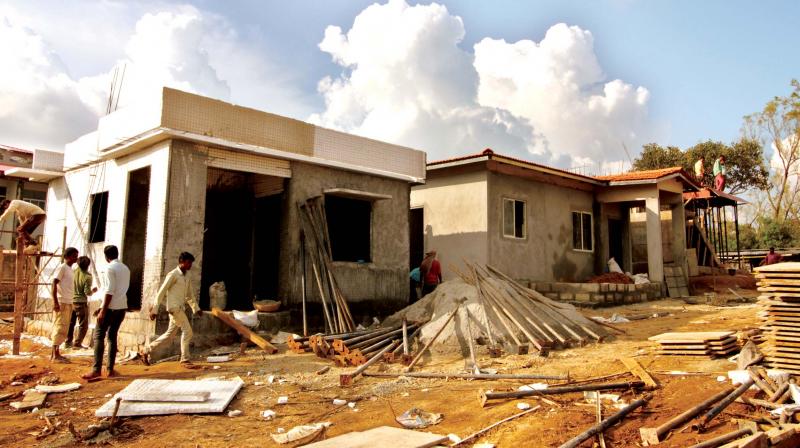Needed in devastated Kodagu: Rehab with a human face
People are desperately trying to retrieve whatever they can and rebuild their devastated lives

When a massive rehabilitation effort goes awry, when houses are built which do not suit the needs of those who have gone through a horrendous deluge, when funds flow in but are not put to use to ameliorate the pain and agony of those who need it most, one could say that a massive disaster is waiting to happen. This is the last thing Kodagu needs after being pummeled and pulverized by umpteen landslides and disastrous spells of rain which had houses slipping dangerously down the hill slopes, roads washed away like sand and people leaving all that they valued most to reach safer spots. Vinay Madhav explores various facets of the rehabilitation effort in the hilly district and explains why things could go terribly wrong if the government and agencies involved in this herculean endeavour, do not painstakingly study the specific problems and needs of Kodagu to make sure its people start smiling again.
What is Kodagu looking for after the rains washed away everything the Kodava had before his eyes? The gloomy face of Pradeep sums up the pathos as he keenly watches buckets and buckets of muck being removed from his house in Makkandur and dumped outside. In fact half of the house was washed away down the valley during the landslides.
“This is my brother’s house, built one year and two months ago. The government has declared it partially damaged and we don’t know how much compensation we will get. The revenue Inspector said that we will not get anything for furniture and other things we lost. We have paid Rs 25,000 to the labourers to clear the muck,’’ he said.
People are desperately trying to retrieve whatever they can and rebuild their devastated lives. “We noticed something in the nearby land and realized it was a refrigerator. We informed the owners and now they are seeing if they can retrieve valuables from the place,’’ said Pradeep.
This is a common sight in most places in Kodagu after the landslides in mid-August. Initially people were amused when they witnessed the first landslide at Makkandur on August 15. They made a beeline for the spot and sympathised with the land owner but by the evening, every villager had deserted the place after more landslides tore their lives apart. Not only Makkandur, neighbouring Thanthipala, Devastur, Kalooru Mukkodlu, Monnangeri, Emmethalu, Jodupala, Iggodlu near Madapur and other villages on the Devastur-Somwarpet road witnessed a series of landslides, washing away houses along with coffee estates, forcing people to take shelter in makeshift relief camps set up by the government as well as various community organizations.
A month and a half after the tragedy struck, people are unsure what to expect from the government or the organizations. Most of the organizations have shut the relief camps after 15 days and are sitting on funds donated for flood relief, unsure of how to spend it for the victims.
The government on its part is toeing the guidelines laid down by the National Disaster Response Force (NDRF) while rehabilitating the people and even paying them maintenance money. But not sure of what’s in store for them from the administration, the hardy people of Kodagu are trying to carve out a future by themselves while considering any help from the government as an added bonus.
Giving a broad outline of the relief efforts, Kodagu Special Additional Deputy Commissioner Mr Jagadish said. “We are concentrating on providing permanent shelter to those who have lost their houses. The unit cost of the house would be decided by the cabinet. Meanwhile, a lot of people are coming out with technology to construct houses that suit the Kodagu climate and landscape. People are free to choose any type of house from the model houses or even construct houses on their own, the government will extend financial assistance. We have also identified land for rehabilitating the victims and the formation of the layout will begin in the next 15 days.’
As for the land, the survey is over but some people do not know the survey numbers of the lost land. The government has not yet clearly announced a relief package for the lost land and only after this is done can the district administration announce compensation, said Mr Jagadish.
This also brings up a pertinent question—what happens to others, whose houses are partially damaged and who are living in relatives’ houses? Is it safe to live in a partially damaged house during the next monsoon?
Pradeep said his brother has been given a hostel room at Valmiki Bhavan in Kushalnagar. “They say that new houses will be given only if the old ones are completely damaged. We are not sure if my brother’s family can move in even if it is cleaned. Our aged mother does not want to die anywhere else as she spent most of her life here. We have to see how it goes,’’ he explained.
“I don’t think it will work for us (shifting to a new house). Many people in my village have lost their houses as well as property. No one wants to move out of their native village. We know that we cannot do anything with the lost land but for generations, our families have lived and died here,’’ said Santhosh of Devasthur village.
Santhosh’s family lost over seven acres of coffee plantation in the landslide, but the house is intact. Some of his relatives were not so lucky, they lost everything. Most of them are now living in their relatives’ houses. Santhosh who drives tourists around in his jeep, said that his business has also dropped drastically. Who would like to visit a place after all that devastation they saw on news channels?
Mr Thammoo Poovaiah of Kodagu Ekikarana Ranga does not agree with the government’s plan to build houses elsewhere and hand them over to the victims. “These are people who lived in independent houses in their estates. If they were mentally prepared to live in housing colonies, they would have migrated to Madikeri or other towns and cities long ago. Most people want to rebuild their homes somewhere around the land they lost. That will no doubt make the rehabilitation process difficult if the government wants to go strictly by its guidelines.’’
It’s not only houses people have lost, their coffee estates have been washed away with Makkandur topping the list in lost coffee plantation. Kalooru has lost large tracts of paddy fields and the local residents know nothing can be grown in these lost areas as muck as high as 20-30 feet has covered the top soil. To add to their woes, tourism which had given a big boost to direct and indirect employment, has gone for a toss and rarely is a tourist seen visiting the famed spot now.
Economy on the backfoot
The meteoric rise of the tourism economy of Kodagu will baffle anyone. Traditionally known for coffee, cardamom and pepper along with large tracts of paddy fields, the agro-economy has taken the backseat after people migrated to the tourism industry.
Most of the landslide affected places are cardamom growing areas. Thanks to import of cardamom from Guatemala, the prices have gone down and cardamom growing areas have transformed into coffee estates. With agricultural labourers moving into the construction and tourism sectors, people are slowly abandoning paddy cultivation too.
However, the tourism industry is booming—between 2008-2010, the number of tourists visiting Kodagu was only 50,000, which went up to five lakh during 2012. In 2014- 2015, it went up to 12 lakh and again to 16 lakh in 2016. During the last season, the number of tourists who visited Kodagu reached a whopping 18 lakh.
With tourism coming to a standstill, most people employed in the sector have lost their jobs including auto and jeep operators and employees of business establishments. During the last one month, home stays, resorts, regular shops, hotels and even beauty parlors have incurred losses.
People however feel the drop in tourists is a temporary phenomenon and everything will fall in place. Meanwhile, the timber mafia is trying to make a killing from the disaster as the landslides in Makkandur, Thantipala and Kalooru uprooted a large number of huge trees.
The flip side of a disaster
The disaster has its flip side too. A relief camp at Kushalnagar witnessed an ugly incident with the tahsildar assaulting an inmate, who questioned the quality of food. The inmates retaliated and some of them were arrested for the assault.
A corporator from Bengaluru went to the extent of wondering if people, who were so well dressed, could really be flood victims. A volunteer quipped: “Do you expect them to sit here with begging bowls? We in Kodagu dress well even during funerals. That does not mean we are not in distress.”

